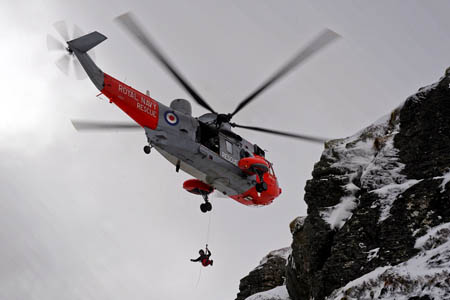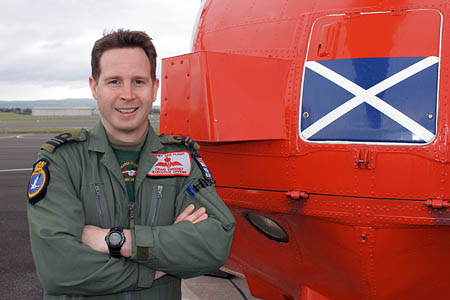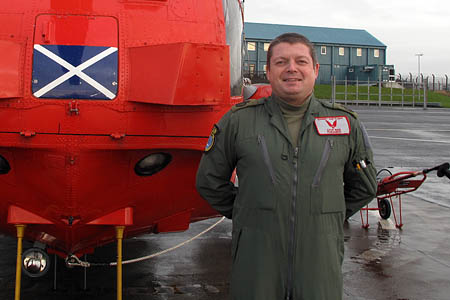A man was rescued in the early hours of this morning after spending almost 24 hours trapped in a blizzard on a Highland mountain.
The walker was reported overdue from a trip in Glencoe and the crew of a Sea King helicopter at HMS Gannet in Ayrshire was scrambled at 5.25am to join the search for the man on Stob Coire nan Lochan.
A Royal Navy spokesperson said the rescuers ‘probably’ saved the man’s life.
The hypothermic walker was found in freezing conditions on a small ledge and airlifted to hospital.
The man had been in the mountains since 8am yesterday, Thursday and the alarm was raised when he failed to return to his accommodation.
The spokesperson said: “Glencoe Mountain Rescue Team was alerted and out on the mountain, but had been unable to locate the walker in appalling blizzard conditions with 50mph winds.
“One of the pilots described the flying conditions as ‘probably the worst I have ever experienced in the mountains’.
“Lost on the 3,658ft [1,115m] Stob Coire nan Lochan, a subsidiary peak to Bidean nam Bian, the man was located by the helicopter at around 2,500ft on a ledge with an overhang above it and nothing but fresh air below it.”
Aircraft commander Lieutenant Commander Craig Sweeney said: “When the alarm went off I assumed it would be a medical transfer job, just because it was so early.
“When we were told it was a climber up a mountain, we knew it could be very serious and that it was likely he had been out all night.
“From being in bed and getting the call to being airborne in the helicopter, it was just 22 minutes.
“It was an extremely dark night and absolutely freezing.
“We managed to speak to the casualty on his mobile as we were flying up and he was very confused. The signal was bad, but we established that he had a torch with him and we advised him to shine it for us once he heard the helicopter, just so that we could locate where he was.
“When we got up the mountain, we could see a number of torch lights and we knew there were five members of Glencoe Mountain Rescue also up there. We asked them to actually flash their torches, which meant we knew that the one remaining rather dim torch we could see, which didn’t flash, was most likely our casualty.
“And luckily it was. We found him very quickly, but he was in a really difficult place on a small ledge with an overhang above him.
“Air temperature on our instruments was –8C and with wind chill I’d hazard a guess that it was probably more like –20C.
“In the helicopter we could just see the rock face out of one side of the aircraft and nothing but whirling snow out of the other.
“Our aircrewman, Chief Petty Officer Dave Rigg, was winched out to where the torchlight was. He was put down on around 100ft of wire, but it wasn’t long before he was reporting back that the snow was so thick he could no longer see the helicopter.
“Considering a Sea King is 9½ tonnes of aircraft and therefore quite big, that’s a good indication of the lack of visibility.
“The substantial experience of both Dave and our observer Lieutenant Commander Martin ‘Florry’ Ford really came into play. With Florry unable to see Dave, he had to essentially use finger-tip touch on the winch wire to sense whether Dave was on the ledge with the casualty or not.
“The whole winch recovery was done by Florry assessing the pressure on the winch line and with purely verbal communications from Dave – it’s rare not to be able to actually see the winchman.
“In the meantime, Lieutenant Jon Wade, my co-pilot, and I were really struggling to control the helicopter with some ferocious up- and down-draughts, not to mention the strong wind.
“It is probably the worst conditions I have ever experienced in the mountains.
“We were going from full power to no power at all in the space of just seconds to try and maintain a steady hover for Florry and Dave.
“Once Dave was with the climber, though, there was no messing around – he got him into a harness really rapidly and they were immediately winched out to the helicopter – it was extremely dangerous on the ledge.
“All in all, from the moment we spotted his light, to him getting in the helicopter was about 10 minutes. It was really hazardous and we wanted to get in and out of there as quickly as we possible could.”
The crew then flew to Fort William, with CPO Rigg, who is also a qualified paramedic, monitoring him en-route.
Once there, the strong winds continued to make life very difficult for the pilots. The Royal Navy spokesperson said: “Landing at West End Car Park in the town is routine for the helicopter, but the strong airs blasting down the mountains meant the crew had to make three landing attempts before getting the Sea King safely on the ground.
“The casualty, who had been well-clothed and equipped, was transferred to Belford Hospital in a waiting ambulance. He was kept in briefly for observation, but has since been discharged.
“The helicopter then returned to the mountain to airlift the five members of the mountain rescue team off the hill.”
“It was really important to us to go back and recover the mountain rescue team,” Lt Cdr Sweeney said. “They had been out on foot in those awful conditions risking their lives for some hours before we even got there.
“They had done a fantastic job, and, I have to say, with the wind at the strength it was and such poor visibility, I’m not surprised they had not managed to locate him.
“Any shouts to try and alert him would have been lost in the wind and, ditto, they wouldn’t have been unlikely to hear any cries for help from him either.”
The RAF’s Aeronautical Rescue Co-ordination Centre at Kinloss Barracks is in charge of scrambling all aviation rescue teams throughout the UK. Commanding officer, Squadron Leader Jon Heald, praised the crew’s efforts, saying: “They not only launched well within declared readiness [in dark hours, search and rescue crews and helicopters should be ready to move in 45 minutes, 15 minutes during the day], but located the casualty quickly, extracted him and managed to transfer him quickly to hospital.
“This prompt reaction most likely saved his life – the response was extremely ‘can-do’ and effective.”


